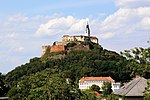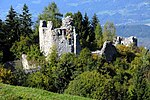Dürnstein Castle
the public
Dürnstein Castle (German: Burgruine Dürnstein) is the ruin of a medieval rock castle in Austria. It is located in Dürnstein, in the Lower Austrian Wachau region on the Danube river, at 312 metres (1,024 ft) above sea level.[1]
History
The castle was erected in the early 12th century at the behest of Hadmar I of Kuenring (d. 1138), a ministerialis in the service of Margrave Leopold III of Austria, on the estates his ancestor Azzo of Gobatsburg had acquired from Tegernsee Abbey in the late 11th century. Hadmar, who also founded nearby Zwettl Abbey, had the fortress constructed in a strategic location overlooking the river Danube. It is connected to Dürnstein through a defensive wall extending from the city walls.
The castle is known for being one of the places where King Richard I of England, returning from the Third Crusade, was imprisoned after being captured near Vienna by Duke Leopold V of Austria, from December 1192 until his extradition to Emperor Henry VI in March 1193.
In 1428 and 1432, Hussite forces plundered the city and castle of Dürnstein.
In 1645, near the end of the Thirty Years' War, a Swedish contingent under Lennart Torstensson conquered Dürnstein. Upon their withdrawal, the troops destroyed parts of the gate system. As of 1662, the castle was no longer inhabited permanently, but was still listed as a possible shelter in the Austro-Turkish War (1663–1664).
In 1663, Conrad Balthasar of Starhemberg purchased the castle, which is still owned by his heirs to this date. From 1679 on, however, the castle was no longer habitable and was abandoned. Today, the fortress is part of the "Wachau Cultural Landscape" UNESCO World Heritage Site.[2]
Gallery
-
 Castle from the east
Castle from the east - Southwest view of castle
-
 Archways inside the castle
Archways inside the castle -
 Cellar entrance, inner courtyard
Cellar entrance, inner courtyard -
 Main tower ruins
Main tower ruins -
 Engraving circa 1842
Engraving circa 1842 -
 1839 illustration from the north
1839 illustration from the north -
 Town of Dürnstein with castle overlooking
Town of Dürnstein with castle overlooking -
 Castle and town from the north
Castle and town from the north
See also
References

- ^ Burgruine Dürnstein Elevation and Position
- ^ "United Nations Educational, Scientific And Cultural Organization Convention Concerning The Protection Of The World Cultural And Natural Heritage, World Heritage Committee:Twenty-fourth session, Cairns, Australia:27 November – 2 December 2000: Report". Unesco.org. Retrieved December 5, 2010.
- v
- t
- e







- Burgruine Aichelburg
- Klosterruine Arnoldstein
- Burgruine Dietrichstein
- Burgruine Falkenstein (Oberfalkenstein)
- Burg Falkenstein (Niederfalkenstein)
- Burgruine Feldsberg
- Burgruine Federaun
- Burgruine Finkenstein
- Burgruine Flaschberg
- Burg Freiberg
- Burg Geyersberg
- Burgruine Glanegg
- Burgruine Gmünd
- Burgruine Goldenstein
- Burgruine Gomarn
- Burgruine Gradenegg
- Burgruine Grafenstein
- Burgruine Greifenfels
- Burgruine Griffen
- Burgruine Groppenstein
- Burgruine Grünburg
- Burgruine Gurnitz
- Burg Haimburg
- Burgruine Hardegg
- Burgruine Hartneidstein
- Burgruine Himmelberg
- Burg Hochosterwitz
- Burgruine Hohenburg
- Burgruine Hohenburg auf Rosenberg
- Burgruine Hohenwart
- Schloss Hollenburg
- Burgruine Karlsberg
- Burgruine Kühnburg
- Burgruine Landskron
- Burgruine Lavant
- Burgruine Leobenegg
- Burgruine Leonstein
- Burgruine Lichtengraben/Painburg
- Burgruine Liemberg
- Burgruine Liebenfels
- Burg Mannsberg
- Burgruine Moosburg/Arnulfsfeste
- Burg Neudenstein
- Burgruine Nussberg
- Burgruine Ortenburg
- Burgruine Petersberg
- Burgruine Prägrad
- Burgruine Rabenstein
- Burgruine Ras
- Burgruine Rauchenkatsch
- Burgruine Rauterburg
- Burgruine Rechberg
- Burgruine Reifnitz
- Burgruine Reinegg
- Burgruine Reisberg
- Burgruine Rosegg
- Burgruine Rothenthurn
- Burgruine Rottenstein
- Burgruine Schaumburg
- Burgruine Silberberg
- Burg Sommeregg
- Burgruine Sonegg
- Burgruine Sternberg
- Burgruine Steuerberg
- Burg Straßburg
- Burgruine Straßfried
- Burgruine Taggenbrunn
- Burgruine Treffen
- Burgruine Twimberg
- Burgruine Waisenberg
- Burgruine Weidenburg
- Burgruine Weißenegg
- Burgruine Wullroß
- Burgruine Aggstein
- Burgruine Araburg
- Burgruine Dobra
- Burgruine Dürnstein
- Castle Falkenstein (Lower Austria)
- Franzensburg
- Burg Greifenstein
- Burg Grub
- Burg Hardegg
- Burg Hartenstein
- Burg Heidenreichstein
- Burgruine Kaja
- Burg Karlstein
- Burgruine Kollmitz
- Burg Kreuzenstein
- Burg Liechtenstein
- Burgruine Mödling
- Burg Neulengbach
- Burg Ottenstein
- Burg Perchtoldsdorf
- Burg Plankenstein
- Burg Persenbeug
- Burg Raabs an der Thaya
- Burg Rappottenstein
- Burgruine Rauheneck (Baden)
- Burgruine Rauhenstein
- Rosenburg
- Schallaburg
- Burg Scharfeneck
- Burg Seebenstein
- Burgruine Senftenberg
- Burgruine Starhemberg
- Schloss Walpersdorf
- Burg Wiener Neustadt
- Burg Alt-Teuffenbach
- Burg Baiersdorf
- Burg Deutschlandsberg
- Burg Dürnstein
- Schloss Eggenberg (Graz)
- Burg Ehrenfels (St. Radegund)
- Schloss Ehrenhausen
- Burgruine Eppenstein
- Schloss Feistritz / Ilz
- Burg Festenburg
- Burgruine Fohnsdorf
- Burg Forchtenstein
- Frauenburg (castle)
- Schloss Frondsberg
- Burgruine Gallenstein
- Schloss Gleichenberg
- Schloss Grosssölk
- Burg Grünfels
- Schloss Gutenberg
- Ruine Hauenstein
- Ruine Henneberg
- Schloss Herberstein
- Ruine Hohenwang
- Burg Kammerstein/ Ehrenfels
- Ruine Kalsberg
- Burg Kaisersberg
- Ruine Katsch
- Ruine Klingenstein /Salla
- Ruine Klöch
- Burg Krems
- Ruine Ligist
- Burg Neuberg
- Burg Neuhaus bei Stubenberg
- Ruine Neu-Leonroth
- Burg Lichtenegg
- Ruine Liechtenstein
- Ruine Neudeck
- Burg Oberkapfenberg
- Burg Obervoitsberg
- Ruine Offenburg
- Ruine Pernegg
- Ruine Pflindsberg
- Burgruine Pfannberg
- Burgruine Pikeroi
- Ruine Puxer-Loch
- Ruine Raabeck
- Schloss Rabenstein
- Burgruine Reifenstein
- Riegersburg Castle
- Burg Schachenstein
- Ruine Schmirnberg
- Schloss Seggau
- Burgruine Steinschloß
- Burgruine Sturmberg
- Burg Thalberg
- Burg Waldstein
- Burgruine Waxenegg
- Burgruine Wildon
- Burgruine Wolkenstein






















